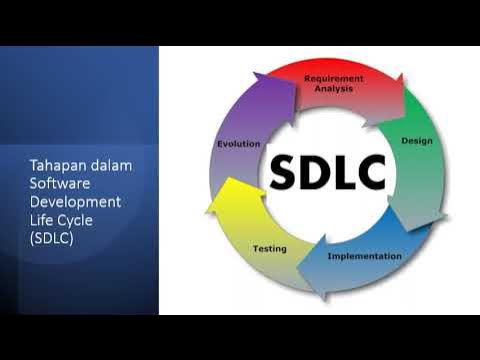INFORMATIKA MATERI 1
Summary
TLDRThis video explores the essential stages of developing digital technology products, focusing on the software development life cycle (SDLC). It covers key phases such as planning, needs analysis, design, development, testing, launch, and maintenance, all critical for creating functional and high-quality applications. The video also introduces other development models like Waterfall, Agile, and Spiral, explaining how they adapt to project needs. Using a mobile app development case study, it provides a practical perspective on how these stages come together. The video aims to help viewers understand the process and challenges in creating successful digital products.
Takeaways
- 😀 Digital product development is a structured process involving various stages, including needs analysis, design, development, testing, and maintenance.
- 😀 Understanding the process flow of developing digital products is essential for creating applications that meet user needs and expectations.
- 😀 The Software Development Life Cycle (SDLC) is a key model used for developing digital technology programs, guiding the process from planning to maintenance.
- 😀 Needs analysis is critical for determining user requirements, ensuring the product meets its goals through market research, user interviews, and feasibility studies.
- 😀 System design involves architectural design, UI/UX design, and database design to create an intuitive, user-friendly, and effective application.
- 😀 Development/implementation stage focuses on writing code, integrating systems, and making necessary adjustments to meet design specifications.
- 😀 Testing is vital to ensure each component functions as intended, including unit testing, integration testing, and user acceptance testing.
- 😀 The product launch phase involves making the application available for users, either to a limited group or the general public, through platforms like Google Play or the App Store.
- 😀 Maintenance and updates are essential for ensuring continued functionality, fixing bugs, and adding new features based on user feedback.
- 😀 The process can follow different models, such as the waterfall model, agile (sprint-based) model, or spiral model, depending on the project needs.
- 😀 Challenges in digital product development include dealing with changing user needs, time and budget constraints, and ensuring security, especially regarding data protection and transactions.
Q & A
What are the key stages in developing a digital technology product?
-The key stages include planning and needs analysis, system design, development/implementation, testing, launch/deployment, and maintenance/updates.
Why is needs analysis important in the development process?
-Needs analysis ensures that the product meets user requirements by identifying essential features and functionalities, based on user interviews, market trends, and feasibility studies.
How does the system design stage contribute to a digital product's success?
-System design defines the product's structure, user interface, user experience, and database, ensuring that the application is functional, intuitive, and capable of handling data efficiently.
What is the role of programming in the development stage?
-During programming, developers write code according to the design specifications using appropriate programming languages, ensuring system integration and functionality.
What types of testing are involved in the development process?
-The types of testing include unit testing (for individual components), integration testing (for overall system functionality), and user acceptance testing (to ensure the product meets user needs).
What is the significance of bug fixing after testing?
-Bug fixing addresses any errors identified during testing to ensure the product is stable, functional, and meets the intended requirements before launch.
How is an application launched after development?
-An application is launched either to a limited group or the general public through platforms like the Google Play Store or Apple App Store for mobile apps, or a server/cloud for web-based applications.
Why is maintenance and regular updates important after launch?
-Maintenance and updates help fix bugs, improve performance, and introduce new features, ensuring the product continues to meet user needs and performs well over time.
What are the challenges faced during the development of digital products?
-Challenges include changing user needs, budget and time constraints, and ensuring security, particularly with personal data and transactions.
What are the different software development models mentioned in the script?
-The different development models include the Waterfall model (linear approach), Agile model (short iterative cycles or sprints), and Spiral model (iterative with risk evaluation).
Outlines

This section is available to paid users only. Please upgrade to access this part.
Upgrade NowMindmap

This section is available to paid users only. Please upgrade to access this part.
Upgrade NowKeywords

This section is available to paid users only. Please upgrade to access this part.
Upgrade NowHighlights

This section is available to paid users only. Please upgrade to access this part.
Upgrade NowTranscripts

This section is available to paid users only. Please upgrade to access this part.
Upgrade NowBrowse More Related Video

Sub Topic 1

Pengantar Rekayasa Perangkat Lunak (Software Engineering)

APSI 2 (PART 1) - METODE PENGEMBANGAN SISTEM (SDLC)

SE 1 : Introduction to Software Engineering | Nature of Software | SE Full Course

Software Testing Tutorial #6 - Software Development Life Cycle (SDLC)

Kelompok 9 - Paper Review Secure SDLC
5.0 / 5 (0 votes)